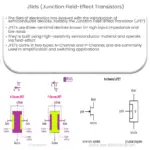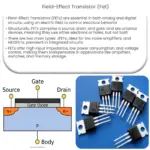Transistors work in a circuit as amplifiers and switches, controlling current flow by using a small input voltage or current to control a larger output.
How Transistors Work in a Circuit
Transistors are essential components in electronic circuits, serving as both amplifiers and switches. To understand how they work, we must first look at their structure and the principle behind their operation.
Transistor Structure
There are two primary types of transistors: Bipolar Junction Transistors (BJTs) and Field-Effect Transistors (FETs). BJTs are made of three semiconductor layers, forming two PN junctions, while FETs consist of a semiconductor channel with a gate terminal controlling the current flow.
BJT Operation
In a BJT, the three layers are called the emitter, base, and collector. The emitter and collector are typically doped with opposite semiconductor materials, either NPN or PNP. The base is a thin layer between the emitter and collector.
When a small voltage is applied to the base-emitter junction, it allows a current to flow between the emitter and base, controlling the current flow between the emitter and collector. The ratio between the collector current and the base current is called the current gain, or beta (β).
FET Operation
FETs operate by controlling the flow of current through a semiconductor channel between the source and drain terminals. The gate terminal, which is insulated from the channel, modulates the current flow. The voltage applied to the gate determines the conductivity of the channel.
There are two main types of FETs: Junction Field-Effect Transistors (JFETs) and Metal-Oxide-Semiconductor Field-Effect Transistors (MOSFETs). JFETs use a PN junction as the gate, while MOSFETs use a metal gate insulated by an oxide layer.
Transistor Applications
Transistors can serve many purposes in electronic circuits:
- Amplification: Transistors can amplify weak signals, such as those from microphones or sensors, to a level suitable for further processing or output.
- Switching: Transistors can act as electronic switches, controlling the flow of current through a circuit in response to a control signal.
- Signal Modulation: Transistors can modulate signals, combining or separating them for applications like radio transmission and reception.
- Logic Gates: Transistors are fundamental components of digital circuits, forming the basis of logic gates used in computers and other digital devices.
Understanding how transistors work is crucial for anyone working with electronic circuits, as they are indispensable for a wide range of applications.





